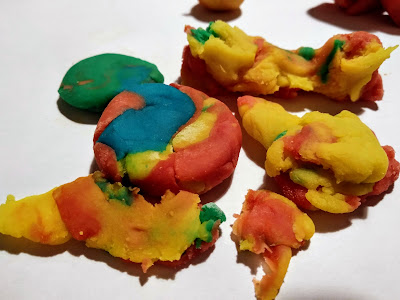The recipe
The ingredients are simple:- all-purpose white flour: you need simple flour without any additives. The last time I was making tons of this dough I tried type 'ostra' (Slovenian type), because I had 2 packs of it and wanted to get rid of them. It worked even better, because it was easier to mix it without clumps and the dough turned out whiter;
- water - room temperature or lukewarm;
- salt - any salt, but the smaller its crystals are, the easier it is to dissolve it;
- acid (citric acid, cream of tartar or lemon juice) - I use citric acid, because I always have it for cleaning the kettle. Acid allows the dough to be stored longer, so if you don't store it, you can omit it;
- oil (refined) - makes it more elastic;
- food coloring.
The general proportions are:
1 cup of flour
1 cup of water
1/3 cup of salt
1 tsp of citric acid/ 6 tsp of lemon juice/ 2 tsp of cream of tartar
1 tbsp of oil
What's the trick?
The process is simple: mix well everything and cook. And this is where I feel important to share the main trick: dissolve the salt first! Types of salt are different and its weight in 1/3 cup is different. If you don't dissolve it, you'll get hard crystals in the play dough. No catastrophe but we want the smoothest dough, don't we? So, from our school chemistry we remember (do we? 😉) that max. amount of salt we can dissolve in 100 gr of water is 36 gr. You can use kitchen scales and take 250 gr of water and 90 gr of salt. But I take it roughly and mix until the salt (and acid crystals) is dissolved. Usually some salt can't be dissolved and I leave it on the bottom. For the dough I mix a cup of flour and and a cup of salty-acidic solution.I don't recommend cooking (on the frying pan I mean) more than that amount of dough (1 cup of flour etc) at a time, because it becomes harder to mix it and control the consistency.
As for the coloring, you can add it to the dough mix before cooking. If you want to make several colors, you can also cook a lot of white dough, divide it and then mix in the coloring. In that case take care to use gloves (for each color) and knead the dough on a surface you can easily clean after each color. For my kids I cook only 1-2 colors every time (and add the coloring before cooking), because they'll mix all colors and it'll become brownish.
Here's a video (not mine) of the cooking process: VIDEO
The last time we cooked 7,2 kg of the play dough for the winter fair at school.
How to store
You need to wrap your play dough in a plastic film and that's it. We store it wrapped in a box with cutters for the dough. However, you can also make bigger amounts and store it in a fridge. Once, I stored it in a fridge for a year! And it was still fine. You may only need to peel white salty layer if it appears. Also if kids leave it unwrapped (and they always do), it won't dry out immediately. Actually, you can make something of it, brush it with acrylic finish and leave it dry. Without finish it'll get white salty layer.






0 comments:
Post a Comment